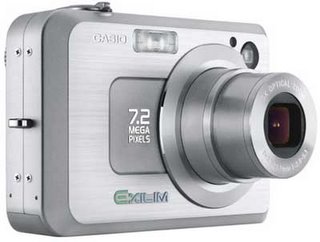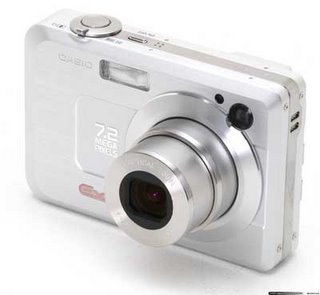Casio Exilim EX-Z750
 DC Recource Review:
DC Recource Review:The Casio Exilim EX-Z750 ($440) is an ultra compact camera with a 7.2 Megapixel CCD, 3X optical zoom lens, large 2.5" LCD display, high quality movie mode, and much more. For better or for worse the market is suddenly becoming crowded with small, high resolution cameras like this: Canon, Nikon, and Sony all have similar models. That means that the Z750 has its work cut out for it. How does it perform? Find out now in our review!
What's in the Box?
The Exilim EX-Z750 has an average bundle. Inside the box, you'll find:
* The 7.2 effective Megapixel Casio Exilim EX-Z750 digital camera
* NP-40 rechargeable lithium-ion battery
* AC adapter
* USB camera cradle
* Wrist strap
* USB cable
* A/V cable
* CD-ROM featuring Casio PhotoLoader and PhotoHands, Ulead Movie Wizard SE VCD, and drivers
* Printed basic manual + full manual on CD-ROM
Casio is one of those camera manufacturers who doesn't include a memory card with their camera. Instead, they build some memory right into the camera. Unfortunately Casio gives you an absurdly low amount of built-in memory on this 7 Megapixel camera -- just 8.3MB. You can fit one -- yes, one -- photo (at the highest quality setting) into that amount of space, so consider a larger memory card to be a requirement. I'd recommend a 512MB or larger Secure Digital (SD) memory card to start with. A high speed card is not necessary based on my own experiences and also because Casio doesn't mention such a requirement anywhere.
I don't know how they do it, but Casio manages to get great battery life out of their cameras. Using the included NP-40 lithium ion battery (which has just 4.6 Wh of energy) the camera can take a whopping 325 shots per charge! Compare that with 160 shots on the Canon SD500, 270 shots on the Nikon Coolpix 7900, and 370 shots on the Sony Cyber-shot DSC-P200 (nice!).
My usual complaints about proprietary batteries like the one used by the EX-Z750 apply here. They're expensive ($45 a pop), and you can't put in a set of alkalines to get you through the rest of the day like you could with an AA-based camera.
The camera dock is used for battery charging, transferring photos to your PC, or viewing photos on a television. While there's no option for transferring photos without the dock, Casio does sell a video out cable that connects directly to the camera for a whopping $25. [Paragraph updated 5/18/05]
To charge the battery just pop the camera into the cradle and you're set -- it takes about 3 hours to fully charge the NP-40. An external battery charger is sold separately.
How Does it Compare?
The Casio Exilim EX-Z750 is a very nice 7 Megapixel ultra-compact camera with a few annoying flaws. First, the good points. The Z750 is compact, made of metal, and is well constructed. It fits easily in your pocket and can go anywhere you do. The camera has a large 2.5" LCD display and a tiny optical viewfinder. While the screen is big, the resolution is not, and low light visibility is not very good either. Camera performance is excellent. The Z750 starts up in just one second and focusing, shutter lag, and shot-to-shot speeds are all very good. The camera's AF-assist lamp helped it focus well in low light situations. Battery life is superb compared to most other ultra-compacts.

Image quality is very good if you tweak a few settings. The biggest problem in this area is the very oversaturated colors in nearly all of my photos. Thankfully there's a workaround -- change the saturation setting in the record menu to -1. And while I'm at it, I'd also suggest reducing the sharpness to the same number, as photos were a little too sharp for my eyes. Redeye was also a big problem, as is usually the case with ultra-compact cameras. Aside from that, the news is all good: exposure was accurate, purple fringing levels were low, and noise levels were comparable to other cameras in this class.
The EX-Z750 has plenty of features to talk about as well. It has tons (and I mean tons) of scene modes that even extend to movie mode. If you want manual controls, they're all here, though I don't like the limited aperture choices. Speaking of movie mode, the Z750's is excellent. You can record high quality VGA (30 fps) video until the memory card is full. Thanks to Casio's use of the MPEG-4 codec file sizes are small and a high speed memory card is not required. The downside is that Mac compatibility isn't the best. The camera offers several movie modes and you can edit your "films" when they're done or grab frames from them.
I have a few more complaints that don't really fit anywhere else. I don't like how the camera requires you to use the (included) camera dock for transferring photos to your computer. The Z750's flash is on the weak side when compared to other cameras in its class. The continuous shooting modes leave much to be desired -- you can take just 2 shots in a row at 1.1 fps at the highest quality setting. The Z750 has an appallingly low amount of built-in memory, which is really inexcusable on a 7.2 Megapixel camera like this. And finally, I'd like my full camera manual in print, thank you!
Overall, the EX-Z750 gets my recommendation. A lot of people are trying to choose between the Z750 and the Canon SD500, and here are some things to consider. For an easy point-and-shoot camera that takes great pictures right out of the box, the SD500 is probably the best choice. If you want manual controls and the ability to tweak camera settings, choose the Z750. For low light shooting I preferred the SD500 due to its LCD that "gains up" in those conditions. The SD500 had a more powerful flash as well, though the Z750's Flash Assist feature makes up for its weaker flash. If battery life is paramount then the Z750 wins by a large margin. In terms of continuous shooting performance the SD500 wins easily, though it has no "fast shutter speed" or shutter priority mode like the Z750 does. Regardless of which of the two cameras you end up with, both are good choices. Take what you've learned in this review and the SD500 review and decide which is best for your needs.
PC Mag Review:
The 7.2-megapixel Exilim EX-Z750 has all the strengths we're used to seeing from Casio cameras, like an effective menu structure and innovative video features. Overall, it's an easy-to-use ultracompact, but testing revealed a few picture-quality problems.
The camera's zoom covers 7.9 mm to 23.7 mm (a 35-mm equivalent of 38 mm to 114 mm), with an aperture range of f/2.8 to f/5.1. But what you'll notice first is the EX-Z750's very large 2.5-inch LCD, with adjustable brightness settings. We could see the image on the LCD even in bright light, but we appreciate that the camera also has a tiny viewfinder, a feature many manufacturers seem eager to remove from their ultracompacts. We feel it's still a useful thing to have. We were glad to see that the USB cradle, which you'll need to connect the camera to your PC, is fairly sturdy.
We also like the nicely displayed menus, always a strong point for Casio. The camera even has shortcut keys for quick access to important features such as resolution and ISO settings. The handy Best Shot mode comes with 30 different auto settings, some artsy, such as pastel and illustration, and some practical, like a setting for copying business cards. All worked reasonably well.
Yet despite the variety of scene modes, the camera could have done better on our still-life camera tests. The daylight shot was somewhat underexposed, and the strobe blew out some of the details in the flash shot. We found some noise and fringing in both the daylight and the flash shots, though the color saturation and color accuracy were adequate. The camera received an acceptable score of 1,575 average lines of resolution, and it booted up in a zippy 2.3 seconds. The recycle time was respectable at 2.9 seconds. We didn't find much shutter lag, nor did we see very much distortion in the zoom range of the lens.
The camera allows you to take MPEG-4 movies at 30 frames per second (at 640 by 480 pixels), which gave us clear videos with pretty good sound. The EX-Z750 also includes a past-movie function similar to the one found on the Casio Exilim EX-P505 hybrid camera. The feature is kind of a "time-shifting" function for cameras: Once the mode is activated, the camera records everything it sees without permanently saving the video. Press the shoot button and it saves the previous 4 seconds of footage along with the next 4 seconds, perfect for capturing your child's home run. We didn't see any unusual battery drain when the feature was activated, and by using a buffer for the temporary footage, it avoids devouring your storage space.
Despite some minor issues with image quality, the Casio Exilim EX-Z750 is a good choice for a multipurpose ultracompact. For cameras around the same price, though, we still prefer the comparison chart and benchmark test results.

0 Comments:
Post a Comment
<< Home